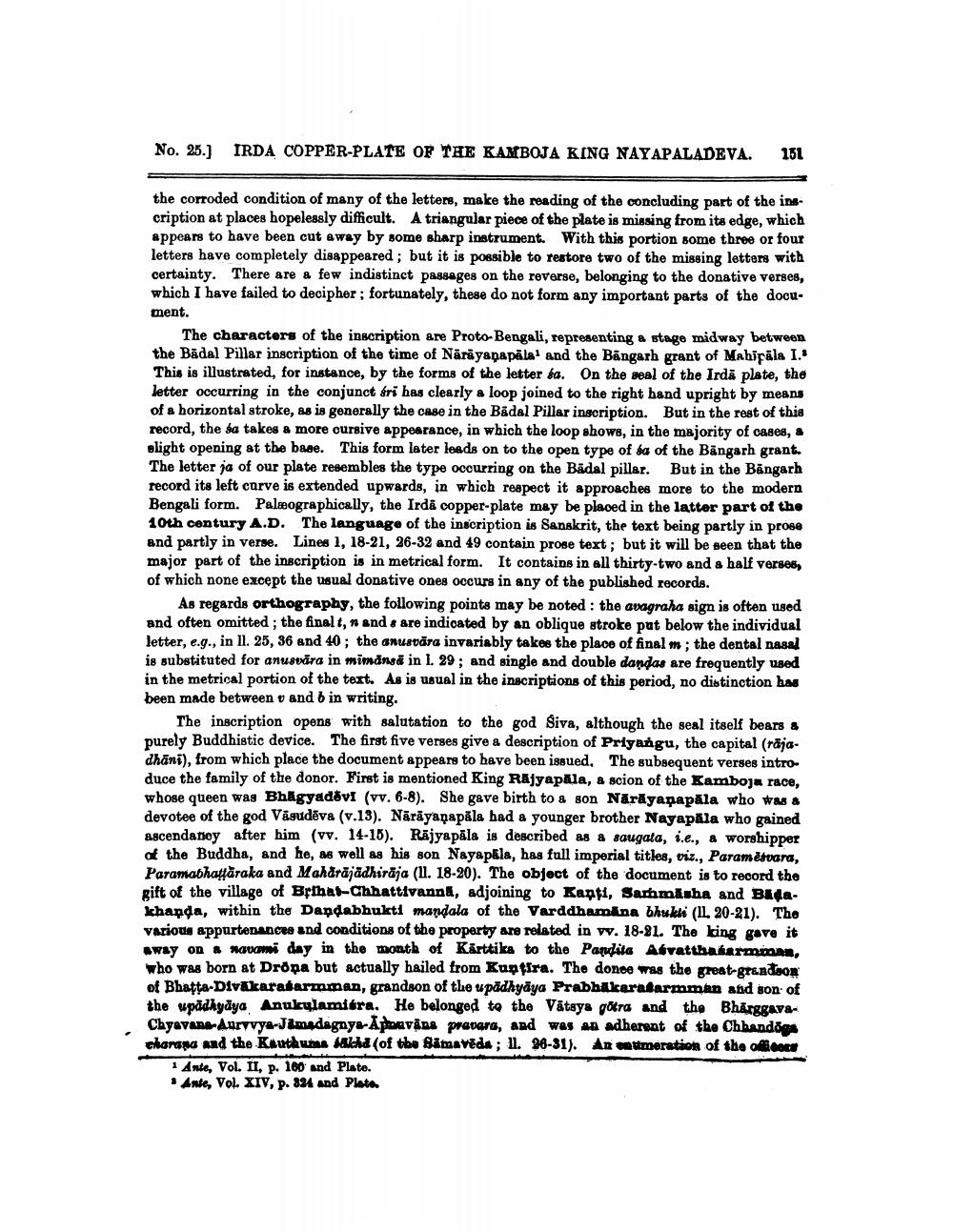________________
No. 25.] IRDA COPPER-PLATE OF THE KAMBOJA KING NAYAPALADEVA.
the corroded condition of many of the letters, make the reading of the concluding part of the inscription at places hopelessly difficult. A triangular piece of the plate is missing from its edge, which appears to have been cut away by some sharp instrument. With this portion some three or four letters have completely disappeared; but it is possible to restore two of the missing letters with certainty. There are a few indistinct passages on the reverse, belonging to the donative verses, which I have failed to decipher; fortunately, these do not form any important parts of the docu
ment.
151
The characters of the inscription are Proto-Bengali, representing a stage midway between the Badal Pillar inscription of the time of Nārāyapapala' and the Bangarh grant of Mahipala I.' This is illustrated, for instance, by the forms of the letter sa. On the seal of the Irda plate, the letter occurring in the conjunct ári has clearly a loop joined to the right hand upright by means of a horizontal stroke, as is generally the case in the Bädal Pillar inscription. But in the rest of this record, the sa takes a more cursive appearance, in which the loop shows, in the majority of cases, a slight opening at the base. This form later leads on to the open type of sa of the Bangarh grant. The letter ja of our plate resembles the type occurring on the Bädal pillar. But in the Bangarh record its left curve is extended upwards, in which respect it approaches more to the modern Bengali form. Palæographically, the Irda copper-plate may be placed in the latter part of the 10th century A.D. The language of the inscription is Sanskrit, the text being partly in prose and partly in verse. Lines 1, 18-21, 26-32 and 49 contain prose text; but it will be seen that the major part of the inscription is in metrical form. It contains in all thirty-two and a half verses, of which none except the usual donative ones occurs in any of the published records.
As regards orthography, the following points may be noted: the avagraha sign is often used and often omitted; the final t, n and s are indicated by an oblique stroke put below the individual letter, e.g., in ll. 25, 36 and 40; the anusvara invariably takes the place of final m; the dental nasal is substituted for anusvära in mimänsä in 1. 29; and single and double dandas are frequently used in the metrical portion of the text. As is usual in the inscriptions of this period, no distinction has been made between v and b in writing.
The inscription opens with salutation to the god Siva, although the seal itself bears a purely Buddhistic device. The first five verses give a description of Priyangu, the capital (rājadhani), from which place the document appears to have been issued. The subsequent verses introduce the family of the donor. First is mentioned King Rajyapala, a scion of the Kamboja race, whose queen was Bhagyadovi (vv. 6-8). She gave birth to a son Nārāyaṇapala who was a devotee of the god Vasudeva (v.13). Nārāyaṇapala had a younger brother Nayapala who gained ascendancy after him (vv. 14-15). Rajyapala is described as a saugata, i.e., a worshipper of the Buddha, and he, as well as his son Nayapala, has full imperial titles, viz., Paramèsvara, Paramabhattaraka and Mahārājādhirāja (11. 18-20). The object of the document is to record the gift of the village of Brihat-Chhattivannä, adjoining to Kanți, Sarhmäsha and Badakhanda, within the Dandabhukti mandala of the Varddhamana bhukli (11. 20-21). The various appurtenances and conditions of the property are related in vv. 18-21. The king gave it away on a navami day in the month of Karttika to the Pandita Asvatthasarmmas, who was born at Dröna but actually hailed from Kuntira. The donee was the great-grandson of Bhatta-Divakarasarmman, grandson of the upadhyaya Prabhakarasarmman and son of the upadhyaya Anukulamiéra. He belonged to the Vatsya gotra and the BharggavaChyavana-Aurvvya-Jamadagnya-Ahavana pravara, and was an adherent of the Chhandōga charapa and the Kauthuma sakcha (of the Samaveda; 11. 26-31). An enumeration of the officers
1 Ante, Vol. II, p. 160 and Plate. Ante, Vol. XIV, p. 324 and Plate.




